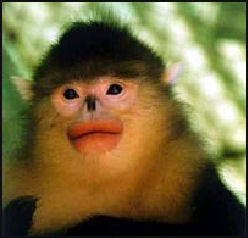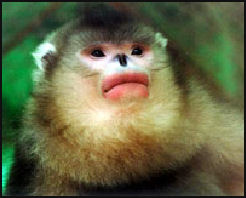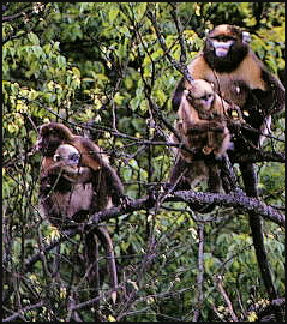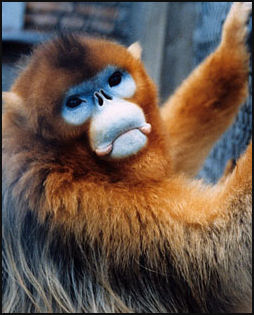SNUB-NOSED MONKEYS

Yunnan snub-nosed monkey Snub-nosed monkeys (also known as snub-nosed langurs) are able to survive in cold temperatures better than any other primate. They live in areas that are covered in snow as much as half of the year; endure winters with sub zero temperatures; and live at elevations up to 4,500 meters, although during the winter they usually descend to lower elevations.
have a head and body length between 51 and 67 centimeters and a tail length of 51 to 97 centimeters. They spend most of their time in trees but come to ground for some feeding and social activities. If threatened they can race through the upper levels of the canopy at great speeds.
Snub-nosed monkeys are among the most endangered primate species in Asia. They have been hunted for centuries for their pelts and body parts, for Chinese medicine. The Manchu valued their pelage which was believed to ward off rheumatism. There are only a few hundred or a few thousand left of each species.
See Separate Article PRIMATES — MONKEYS, MACAQUES, GIBBONS, AND LORISES—IN CHINA factsanddetails.com
RECOMMENDED BOOKS: “The Biology of Snub-Nosed Monleys, Douc Langurs, Proboscis Monkeys, and Simakobus by Cyril C. Grueter Amazon.com; “Tales of the Golden Monkeys” by Yong Yange Amazon.com; “Primate Tales. In Search of the Last Snub-nosed Monkeys of Vietnam” by Kai Althoetmar Amazon.com; “Chinese Wildlife” ( Bradt Travel Wildlife Guides) by Martin Walters Amazon.com; “Guide to the Wildlife of Southwest China” by William McShea, Sheng Li, et al. Amazon.com; “Wild China: Natural Wonders of the World's Most Enigmatic Land by Phil Chapman, George Chan, et al. Amazon.com; “Wildlife of China” by China Wildlife Conservation Association Amazon.com; “Wildlife Wonders of China: A Pictorial Journey through the Lens of Conservationist Xi Zhinong” by Zhinong Xi, Rosamund Kidman Cox, et al. Amazon.com; “Mammals of China (Princeton Pocket Guides” by Andrew T. Smith and Yan Xie Amazon.com; “China Red Data Book of Endangered Animals: Mammalia” by Wang Song Amazon.com; “Rare Wild Animals” (Culture of China) by Yang Chunyan, Zhang Cizu, et al. Amazon.com
Snub-Nosed Monkey Behavior

Yunnan snub-nosed monkey Snub-nosed monkeys primarily eat leaves, grass, lichens, bamboo shoots, buds and fruit. They cover between 1,000 meters and 1,500 meters a day when they forage. Group of 100 and even 600 have been observed but a typical group has a single male, three to five females and their young. Dominant males sometimes fight with rivals who want to claim their females.
Males usually reach sexual maturity when they are seven; females when they are four or five. Birth usually take place in the spring or summer after a 200 day gestation period. Usually one, sometimes two, young are born.
Groups claim a temporary territory of four to 50 square kilometers and change every month. If two different groups meet they usually avoid a conflict and head in different directions. The most frequent vocalization, “ga-ga,” is shrieked out loudly when a food source is found.
Golden snub-nosed monkeys are matriarchal and generally relatively peaceful. PBS caught on film a rare fight sequence between two adult males. PBS said: They would furiously slap each other for about 10 seconds and bound away, then return to repeat the performance. Later, we saw the energetic babies play-fight with one another, imitating the adults.” [Source: Frontline, pbs.org, April 22, 2006]
Species of Snub-Nosed Monkeys in China
There are five related species of snub-nosed monkey. Jennifer S. Holland wrote in National Geographic, They are “remnants of once widespread populations whose ranges were squeezed by climate change after the last ice age. Their scientific name, Rhinopithecus roxellana, was allegedly inspired by the snub-nosed concubine of a 1500s sultan. [Source: Jennifer S. Holland, National Geographic, February 2011]
There are three main mountain species of snub-nosed monkey: 1) the black snub-nosed monkey; 2) the Yunnan snub-nose monkey; and the 3) Sichuan golden snub-nose monkey. There is another species that lives in the lowlands; the Guizhou snub-nose monkey. The pig-tailed snub-nose monkey, Guizhou snub-nose monkey, and black snub-nose monkey are endangered.

Guizhou snub nose monkey The Yunnan Golden Monkey is one of the most threatened species in China. It lives in virgin forests in the mountains southeast of the Tibetan Plateau. The Sichuan golden snub-nose monkey has orange shoulders, a white muzzle and a blue nose. It lives in mixed bamboo, conifer and deciduous forests up to 3,150 meters. Yunnan snub-nosed monkeys are rarely seen and were thought to be extinct in the 1960s
The Yunnan snub-nose monkey has predominately black shoulders. It lives in temperate mountain forests from 3,000 to 4,000 meters, an environment with snow and below freezing temperatures for several months a year. Yunnan snub-nosed monkeys spend most of their time in conifer forest at high elevations but occasionally they climb down to lower elevations to look for food in the broadleaf forests. Lichens stripped from the bark of spruce and fir trees are their main sources of food. Photographer Xi Zhinong told National Geographic, “I found out these monkeys have highways of their own. They always jump from one tree to another at the same spot.”
Black Snub-Nosed Monkey
Black snub-nosed monkeys (Rhinopithecus bieti) have a body length of 74-82 centimeters and a tail length 51-72 centimeters and weigh 17-35 kilograms. They live in coniferous forests in high mountain. They pick their food from trees with their hands and eat tree leaves and bamboo shoots. They can be found in Yunling Mountain in the Northwest of Yunnan, Yunling Mountain in the Southeast of Tibet and in Guizhou. They are regarded as an endangered species. Their pelt was once valued as a remedy for rheumatism. Today they have suffered from loss of habitat as a reuslt of logging. There are believed to be only between 800 and 1,200 left. [Source: Center of Chinese Academy of Sciences, kepu.net]
Black snub-nosed monkeys lives in the highest elevations of any non-human primate: in high mountain forest up to 4,500 meters on a single mountain in the Nujang Lancang Gorge region of Guizhou in China. Males average 15 to 17 kilograms, females average 9 to 12 kilograms Black snub-nosed monkeys spend a lot of time in high evergreen trees. They feed on lichens, leaves, grass and fruit..
Black snub-nosed monkeys are found only in China. They range spend their time in high mountains at elevations between 2500 meters and 5000 meters and favor spruce and fir forests at an elevation between 3500-4500 meters. A black snub-nosed macaque group usually consists 1 male adult, 2-3 female adults and some young macaques. These families hang out together in a territory that can cover tens of square kilometers. After a French man collected a sample in 1890, no news about them was heard for almost 100 years. In 1979, Kunming Institute of Zoology fond evidence of them in the snowy forests of Deqin. Since then more evidence of them has been found.
Golden Monkeys in China
Golden snub-nosed monkeys are sometimes simply called golden monkeys. They are found in remote parts of Shaanxi, Gansu, Sichuan, Guizhou, and Yunnan. About 20,000 remain on Earth. Some 4,000 inhabit the in the Qin Ling Mountains of central China, where Chinese officials set up the Zhouzhi National Nature Reserve to protect the species. The live both in and out of reserve boundaries. [Source: Jennifer S. Holland, National Geographic, February 2011]
Golden snub-nosed monkeys live in the high, cold forests of Sichuan, Gansu, Hubei and Shanxi Province, their habitat often overlapping with that of giant pandas. Deep snow and bitterly cold temperatures are common throughout their habitat in the winter. To stay warm the monkeys huddle together on the branches of trees. Why the odd face? No one is sure, but Penn State primatologist Nina Jablonski suggests the flat muzzle evolved to combat extreme cold, "which would cause frostbite to bare, exposed, fleshy noses."
The golden monkey’s name in Chinese translates to "the blond lady who inhabits on the trees." In the homeland of the giant pandas, they mainly live in the lush crowns of the trees and eat the shoots and the soft leaves of trees as well as the Spanish-moss-like sunlo lichen that hangs from branches and lumpy covering on the bark. [Source: Science Museum of China kepu.net.cn]
Golden Monkeys Behavior

Golden monkey
Golden snub-nosed monkey live in territorial bands that can top 400 animals. Large social networks help fend off predators, like clouded leopards. Mothers outrank barren females and males with multiple mates gain high status. So do males that display "courage and perseverance," biologist Qi Xiao-Guang of Northwest University in Xian, China told National Geographic. Bands may clash when ranges overlap, and "males show their vigor by fighting and forcing the enemy out." Territorial animals, including these and other primates, often do more posturing than injuring — mainly to protect themselves.
The Golden Monkey lives both in the trees and the ground of the theropencedrymion or coniferous forest at an altitude of 1400 meters to 3200 meters. Moving about in groups during the day, the golden monkeys sleep in big trees in groups of three to five. They move vertically in accordance with the season. In summer, they live in the forest with at an altitude of about 3000 meters while getting down to the woods below 1500 meters in winter. [Source: Science Museum of China]
They search for food and play in the trees or on the ground, but only rest in the trees. The diet of a golden monkey consists of plant sprouts, tender blossoms, barks, wild fruits and seeds, and bamboo shoots. Although showing no preference for seasons in breeding, the peak time of mating is between October and August. After 193-203 days' pregnancy, a golden monkey often gives birth to a cub at a time between March to May.
Efforts to Save the Golden Monkeys in China
The Golden snub-nosed monkey is listed in Appendices I as a threatened species on China’s National List for Specially Protected Wild Animals, .The fur for these monkeys was once so highly valued that only the highest officials were allowed to wear it. They have been protected since 1957 but their numbers are falling as a result of loss of habitat. Holland wrote, “Golden snub-nosed monkey are being squeezed by logging, human settlement, and hunters wanting meat, bones (said to have medicinal properties), and luxurious fur. Many have been pushed into high-altitude isolation, where they leap across branches, traverse icy rivers, and weather long winters at nearly 10,000 feet, shielded by that coveted coat. They have made great adaptations to survive, subsisting on low-protein lichens and bark when trees are bare.
In 1995, 40 square miles of virgin rainforest, where golden monkeys live, in Deqin county in Yunnan was sold to logging companies whose environmental impact studies failed to even mention the monkeys. Of the 1,000 Yunnan golden monkeys that remain in the wild about 200 of them live in the Dequin forest. The main timber company involved in deal only sold enough timber to pay about half of its operating costs with the government subsidizing the rest.

Golden monkey A forestry worker from Yunnan named Xi Zhinong almost single-handedly saved the monkey by drawing public attention to its plight. He launched an effort to save the Yunnan snub-nosed monkey after witnessing the animal’s habitat destroyed by logging. After failing to win any support from Yunnan officials, who he said at one point "even hinted that they could make me disappear," Xi went to Beijing where he organized students into candle-light "Save the Monkey" demonstrations under banners that read "LIVE AND LET LIVE" and "FORESTS FOR THE FUTURE."
Petitions were sent to national leaders asking for help, the media picked up the story and college students camped in the monkey’s forest to draw publicity to the monkey’s plight. Photos by Xi of snub-nosed monkeys were widely circulated. They captured people’s hearts and helped win support for he effort to save the forest.
The logging plans were eventually halted and the habitat was saved. Xi lost his job in the forestry department but his photos helped launch a new career as a photographer and he is now China’s most sought-after wildlife photographer. China's first and, for a time, only recognized environmental group, Friends of Nature, grew out of the effort to save the golden monkey. The forest home of the monkeys became a wildlife refuge.
Myanmar Snub-Nosed Monkey — New Species
The Myanmar snub-nosed monkey (Rhinopithecus strykeri) was first described by scientists in 2010 after it was sighted in Kachin state in northeastern Myanmar. An expedition in China led by Yongcheng Long from the Nature Conservancy China Program photographed a group of these monkeys near Pianma, in Yunnan's Lushui County The photos were published in the American Journal of Primatology in July 2012. “Rhinopithecus strykeri is named in honor of Jon Stryker, President and Founder of the Arcus Foundation, which helped fund the initial research. The monkey is know locally as mey nwoah or the 'monkey with an upturned face'.[Source: mongabay.com, July 27, 2012]
The species is critically endangered in China and Myanmar, due to its low population. "The population of this species is hard to estimate, but based on our contacts with the monkey group both in October 2011 and in March 2012 we estimate the population to be less than 100 individuals," said Long. "However, while we now know the home range to be far greater than previously believed, we still do not yet know the true population number or the extent of their home range as the monkeys are shy and very hard to access."
"This monkey group was actually found in an area designated as a nature reserve 30 years ago and while local people have been hunting the species for ages, local managers knew nothing about it," Long said. "This highlights the need to improve wildlife management in China, as it is likely quite a few new species of plants and animals may be discovered in the border areas between China and Myanmar."
Discovery of the Myanmar Snub-Nosed Monkey
Hunters' reports led scientists to discover the Myanmar snub-nosed monkey in the northern forests of Myanmar. Jeremy Hance wrote in mongabay.com, “. Discovered by biologists from the Myanmar Biodiversity and Nature Conservation Association with support from primatologists with Fauna & Flora International (FFI) and the People Resources and Biodiversity Foundation, the strange looking primate added a fifth member to the the snub-nosed monkey family. The small single population is threatened by Chinese logging and hunting. [Source: Jeremy Hance, mongabay.com, October 26, 2010]
Described in the American Journal of Primatology, the new monkey, was only discovered after researchers heard reports from hunters of a strange monkey with upturned nostrils and prominent lips. It is known locally as mey nwoah,or 'monkey with an upturned face'. Locals have an easy time finding the species, since, according to them, it sneezes whenever it rains. Rainwater collects on the monkey's upturned noses causing them to sneeze. To combat this, the monkeys spend their rainy days with heads tucked between legs.
The new primate is especially notable for being the only snub-nosed monkey known in Myanmar. The other four snub-nosed monkey species are found in parts of China and Vietnam. Frank Momberg, FFI’s Regional Program Development Coordinator in the Asia Pacific and co-author of the paper, told mongabay.com that this new species proves "snub-nosed monkeys must have had a much largest distribution in China and adjacent areas in the past," adding that "[the new species] is most closely related to the Yunnan snub-nosed monkey. However, the two species are morphologically very distinct and are now separated by two major species barriers, the Salween and the Mekong River."
National Geographic reported: Based on talks with the Lisu hunters, scientists estimate that only about 300 of these monkeys remain—few enough to qualify R. strykeri for "critically endangered" status on the International Union for Conservation of Nature's Red List of Threatened Species. The discovery of a new monkey in Myanmar proves just how little we know about the country's wildlife according to Momberg. "There is plenty of more species to be discovered [in Myanmar], even mammal species. Myanmar is a priority country for biodiversity conservation with currently the second highest deforestation rate in Asia after Indonesia."
First Photographs of the Myanmar Snub-Nosed Monkey
In 2012, mongabay.com reported, a remote camera trap took the first ever photo of the Myanmar snub-nosed monkey. At that time no scientist has ever seen a living individual.Just setting the camera traps in April 2011 proved incredibly difficult with the expedition battling both snow and rain. The species is only known from a carcass killed by a local hunter."These images are the first record of the animal in its natural habitat," said Ngwe Lwin, a native to Myanmar, who first recognized that the primate may be a new species. "It is great to finally have photographs because they show us something about how and where it actually lives." [Source: Jeremy Hance, mongabay.com, January 10, 2012]
"We were dealing with very tough conditions in a remote and rugged area that contained perhaps fewer than 200 monkeys," explains photographer Jeremy Holden, who led the team. "We didn’t know exactly where they lived, and had to rely on information gathered from hunters; I didn’t hold out much hope." Still a month after setting up the camera traps, the scientists had the first photographic evidence of a living Myanmar snub-nosed monkey, including family groups. "We were very surprised to get these pictures," said biologist Saw Soe Aung. "It was exciting to see that some of the females were carrying babies—a new generation of our rarest primate."
Long Yongcheng, scientist with the Nature Conservancy in China, told the China Daily that his team have discovered 50-100 Myanmar snub-nosed monkeys in the Gaoligong Mountain Natural Reserve near the border with Myanmar in Yunnan Province. Chinese scientists were able to photograph and even videotape the species. But it was the monkey's scat and fur that proved it was the Myanmar snub-nosed monkey: DNA tests showed a 98.2 percent match with the species in Myanmar. [Source: Jeremy Hance, mongabay.com, May 16, 2012]
Protecting the Myanmar Snub-Nosed Monkey
National Geographic reported that soon after the first known specimen of the Myanmar snub-nosed monkey was shown to scientists he hunters that killed it ate it. One hunter told Frank Momberg, FFI's Asia-Pacific development director, they hunt them in the rainy season in the rainy season because: “ It's much easier to find them'" due to the sound. "Hunters hunt them more often in the rainy season, because they are much easier to locate—normally they're pretty quiet,” he said.
Jeremy Hance wrote in mongabay.com: Researchers believe only 260-330 individuals survive of the new species, which would rank it as Critically Endangered according to IUCN Red List standards. Unfortunately, the new species faces a large variety of threats. "Snub-nosed monkey get frequently trapped in traps laid out for bears. Local hunters also use shotguns. Until 8 years ago hunting was primarily for subsistence use only. Since Chinese logging roads are moving closer, hunting is now increasingly supplying bushmeat for local logging and dam construction camps, as well as feeding into the wildlife trade to China," Momberg says. [Source: Jeremy Hance, mongabay.com, October 26, 2010; January 10, 2012]
Snub-nosed monkeys are imperiled by hunting and trapping, but it may be logging that ultimately does them in. In 2010 Frank Momberg, FFI’s Regional Program Development Coordinator in the Asia Pacific, told mongabay.com that hunting in the remote region had recently moved beyond subsistence only: with Chinese logging roads infiltrating the area there has been a rise in commercial bushmeat hunting. At the time, Momberg also warned that the logging roads were expected to move into Myanmar snub-nosed monkey territory by 2011. Myanmar has one of world's the highest deforestation rates, which is at least partly driven by China's rising demand for commodities. Between 1990 and 2010, Myanmar lost 19 percent of its forest cover, or around 7,445,000 hectares, an area larger than Ireland.
"By next year Chinese logging companies will have moved into the Myanmar snub-nosed monkey range, which will cause serious degradation of their habitat and increase hunting pressure," Momberg says. Saving the Myanmar snub-nosed monkey will require quick work on many different issues, according to Momberg. First, the Chinese government must "crackdown on illegal Chinese logging in the area" and "step-up law enforcement of CITES regulations by Chinese customs officers to reduce trans-border illegal wildlife trade."
Image Sources: 1, 2, 3) Chinese Science Museum ; 4, 5) CBCF Primate info; 6) Animal info file; 7, 9) Kostich ; 8) CNTO
Text Sources: New York Times, Washington Post, Los Angeles Times, Times of London, National Geographic, The New Yorker, Time, Newsweek, Reuters, AP, Lonely Planet Guides, Compton’s Encyclopedia and various books and other publications.
Last updated July 2022
